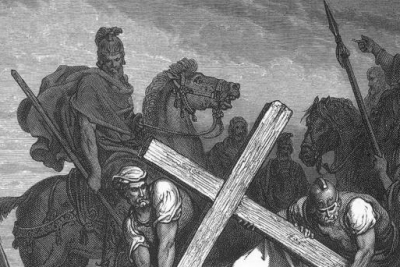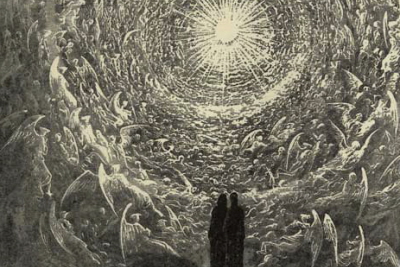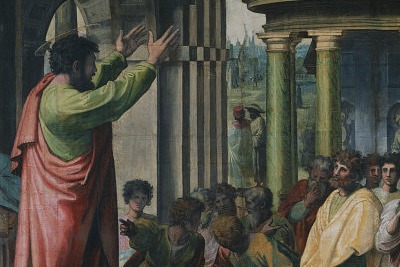
The Four Components of the Gospel
We all know that water is H2O – two hydrogen atoms and one oxygen atom. But without the oxygen, you only have hydrogen gas (H2), a source of clean fuel, but not something you can live on. In fact, hydrogen gas is downright dangerous, because it burns very hot and the flame is nearly invisible.
If you take the hydrogen out of water and leave oxygen (it always combines into at least two oxygen atoms, or O2) you have pure oxygen – this is also highly flammable, and pure oxygen is toxic to breathe. Add a third oxygen atom (O3), and now you have ozone, a good gas for the upper atmosphere, but one linked to heart attacks, asthma, bronchitis, and death.
What is the gospel? Years ago I heard a simple, four-part summary of the gospel that contains the essential message of Jesus Christ. Like water, each component is necessary – take it away, and the gospel is not proclaimed. Still, the gospel isn’t a static message, and at the end of this post, I introduce a few ideas on how to unpack this message.
#1 – God – The first four words of the Bible are “in the beginning, God…” God isn’t a social construct, an idea that people came up with, or a concrete way of thinking about the ultimate reality. God is real, and he exists alone. There is no one like him, no one who rivals him. He is unlike anything else, possessing infinite power, knowledge, wisdom, and existence.
The Bible says that God created the heavens and the earth. Everything that exists is ultimately the creation of God. When we look up at the sun, moon, and stars, and ponder galaxies a billion light-years away, we are looking at God’s handiwork. When we examine microscopic cells and chemical reactions, we see God’s handiwork. All the variety, the order, and the beauty point to the character of God – God is revealing something about himself in the world that he created. All this evidence leads to the rock-solid conclusion that God really does exist.
Ultimately, the Bible is the pre-eminent source for information on God. It tells us not only that he is great and glorious, orderly and beautiful, but also just and merciful. He delights in showing mercy, and giving undeserved kindness to those who don’t deserve it.
At the same time, God calls himself a judge, and he is interested in justice. Anyone who fails to attain the standard of perfection – that standard that God himself has set – must be condemned. Time and again, God reveals his detestation of evil by judging it harshly. It isn’t that God is punitive and judgmental – rather, God is interested in preserving purity and punishing what is disgustingly depraved.
#2 – Man – Man, of course, living in the world, is part of God’s creation. Man is not some highly evolved prehistoric ape, neither is he a random collection of chemicals that happens to possess the characteristic of rational thought. Man is created by God, in His image, with a living soul that continues forever.
Because man was created by God, for God, man is never satisfied without God. Even though people try to satisfy themselves with possessions, relationships, and activities, they fail to find contentment without God.
The Bible teaches that man was created perfect, but Adam and Eve chose to disobey their Maker by eating the forbidden fruit. Suddenly their perfect nature was sullied – indeed, they became spiritually dead. No longer able to obey God from a perfect heart, people – the descendants of Adam and Eve, who continue in their disobedient ways – carry out the disobedient (sinful) desires of their body and mind, working out the passions of their flesh. The mind, created for the highest and noblest thoughts, has become perverted by depravity.
This means that humanity falls under the judgment of God. God is not responsible for man’s evil, but he is responsible to punish man. In fact, God couldn’t claim to be righteous and just if he overlooked humanity’s evil. In response, he cursed both Adam and Eve, and promised them that they would surely die – not just a temporary, physical death, but even an eternal and spiritual death.
#3 – Christ – There is a difficulty – if God is just, he must punish sin. But how could he show mercy and kindness, while maintaining his justice? Desiring to show the riches of his mercy, God sent his Son, Jesus (who is divine) to show his kindness to humanity.
Jesus lived for about thirty-three years on earth, loving other people and loving his Father, God. He showed the kindness of God by healing people, ministering to them, and teaching them. At the same time, he served his heavenly Father by obeying him and devoting himself fully.
The pinnacle of God’s kindness is when Jesus (who is known as the Christ, because he was promised by God) laid down his life, suffering humiliation and death at the hands of Jewish mobs and Roman soldiers when he was crucified on the tree. This death, while a striking example of surrender to God’s will, was far more than just a good example for humanity.
Instead, the Bible teaches that Jesus actually became accursed on the cross, taking on himself the sins of the world, and suffering on the behalf of those who would believe on him. In this way, God maintains his character of justice, but also shows his kindness to humanity.
After Jesus died on the cross, he was buried in a tomb – but he didn’t stay there! Three days later he resurrected, demonstrating the power of God, and he continued to live on earth for forty days. Finally, he ascended into heaven, promising that one day he will return, judging those who refuse to submit to God, and completing the rescue of those who believe on him.
#4 – Response – All of this information is good and true, but the Bible never leaves people to rest content knowing it. Instead, this whole message is meant to move people, to engage their hearts, to humble their pride, and to surrender their lives to the kindness and mercy of God. In particular, the Bible outlines two ways that people must respond to this message.
 First, we are commanded to repent. Repentance is not only a feeling of sorrow or shame – it is an actual change in life! Repentance is like a U-turn – one goes in the opposite direction that they have been travelling in. When someone repents, they forsake their false ideas about God, and they forsake their lifestyle of disobedience. Instead, they follow in the pattern of Jesus, a pattern of obedience to God.
First, we are commanded to repent. Repentance is not only a feeling of sorrow or shame – it is an actual change in life! Repentance is like a U-turn – one goes in the opposite direction that they have been travelling in. When someone repents, they forsake their false ideas about God, and they forsake their lifestyle of disobedience. Instead, they follow in the pattern of Jesus, a pattern of obedience to God.
Second, we are commanded to believe. The gospel is not just facts – it is actual truth. Like a medicine in a cupboard, it does nothing as long as it stays on the shelf. It must be used! Belief implies entire surrender to God’s way, and acceptance of all of God’s message. It becomes the foundation for life and the anchor for everything. It also implies obedience to all that God commands – including baptism, the symbol of a new life lived in obedience to Jesus Christ.
A Few Notes on How to Unpack These Components
Unpack each element. When Peter preached the gospel on the day of Pentecost, he preached a long sermon that is recorded for us. But he also spoke ‘many other words.’ What we have recorded in the Bible is a bare-bones skeleton of Peter’s message. He unpacked each of the different components of his message so that his audience would understand it.
Don’t neglect any component! In the illustration with water, we noticed that water must have each component. Similarly, the gospel must contain each of these four components. A gospel without God makes no sense. A gospel without man and his sinfulness isn’t necessary. A gospel without Christ is no gospel at all. And a gospel without the response is a set of facts, not an invitation into the kingdom of Christ.
Taylor the message to the audience. Each of these four components is crucial, but that does not mean you must spend equal time on them. When Paul preached the gospel to the Jews, he hardly mentioned the first two points, because the Jews were well aware of who God was and the character of man. When Paul preached to the Greeks on Mar’s Hill, he spent most of his time on the first point, because the Greeks needed a solid foundation of who God is.
Do you use all four components? Ask yourself – does my gospel presentation include all four components? I once had a wonderful conversation with a young couple, and spent plenty of time going through the first three components. Later, as I thought about the conversation, I was mortified to realize that I hardly touched on the fourth component. All four aspects of this message are essential.
I’m looking forward to engaging with each of my readers – that is why I am going to begin including some questions at the end of some of my posts. Please, join into the discussion – I value your thoughts!
Do you think these four components adequately summarize the gospel? Have you benefited from other outlines of the gospel?




I’ve found this to be a very helpful outline for sharing the gospel. Sometimes I’ve felt like I don’t even know how to adequately approach evangelistic conversations, but thinking through this outline has helped me not leave out important parts of the message when I share with people. Thanks for writing about this!
Hey Daniel. thanks for the post. I really like the outline and I think it’s very helpful to keep in mind. I am trying to think of a chapter of the Bible or book of the Bible that uses this outline. I don’t think there is one. And I know all 4 points are crucial to a true understanding of the gospel, I don’t think they are needed during every single presentation of the gospel. I love how you brought out that Paul barely spent much time on points 1 and 2 with Jews and a lot of time on point 1 with the Greeks. Sharing the gospel above all else calls for the Spirit’s leading and help in discerning where a person is at and just what to say. It’s better when you actually have a relationship with the one you are sharing because you know them AND you have grown to love them and they know you love them. I think in our day, there are many people(maybe not our age) like the Jews who know a lot about God. I recall in some place Peter was preaching to people to just repent. Sometimes that’s enough depending on situation/context. sometimes it’s not. One of my fav verses is 1 Thess 2:7,8. One could make an argument that a necessary component of the gospel is to have affection for the people with whom you are sharing. and if possible to even share your life with them! Can’t do that for the person we meet in the airplane but I think it’s super important and it takes work and God’s help. 🙂
Amy, thanks for your comment. I agree, it can be difficult to know how to approach evangelistic conversations. That’s why I think an outline like this is helpful!
Michelle, thanks also for your thoughts. You mention a crucial component, having a relationship with people. I was focusing more on the content of the message here, but you are absolutely right that we are called to have this relationship with others. Without love (as Paul tells us) no evangelism will be of any profit for souls!